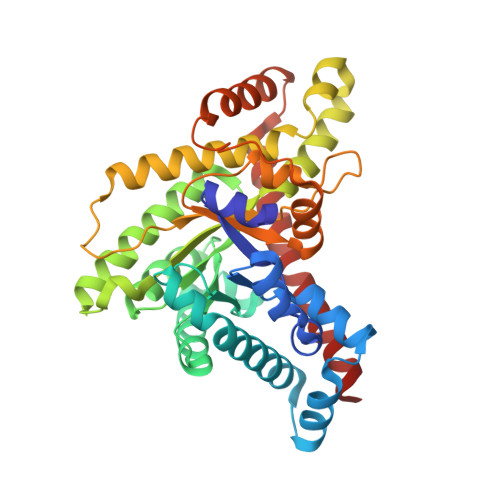Conservation of structure and mechanism within the transaldolase enzyme family.
Samland, A.K., Baier, S., Schurmann, M., Inoue, T., Huf, S., Schneider, G., Sprenger, G.A., Sandalova, T.(2012) FEBS J 279: 766-778
- PubMed: 22212631
- DOI: https://doi.org/10.1111/j.1742-4658.2011.08467.x
- Primary Citation of Related Structures:
3R5E, 3R8R - PubMed Abstract:
Transaldolase (Tal) is involved in the central carbon metabolism, i.e. the non-oxidative pentose phosphate pathway, and is therefore a ubiquitous enzyme. However, Tals show a low degree in sequence identity and vary in length within the enzyme family which previously led to the definition of five subfamilies. We wondered how this variation is conserved in structure and function. To answer this question we characterised and compared the Tals from Bacillus subtilis, Corynebacterium glutamicum and Escherichia coli, each belonging to a different subfamily, with respect to their biochemical properties and structures. The overall structure of the Tal domain, a (β/α)(8) -barrel fold, is well conserved between the different subfamilies but the enzymes show different degrees of oligomerisation (monomer, dimer and decamer). The substrate specificity of the three enzymes investigated is quite similar which is reflected in the conservation of the active site, the phosphate binding site as well as the position of a catalytically important water molecule. All decameric enzymes characterised so far appear to be heat stable no matter whether they originate from a mesophilic or thermophilic organism. Hence, the thermostability might be due to the structural properties, i.e. tight packing, of these enzymes. Database The crystal structures have been deposited in the Protein Data Bank with accession code 3R8R for BsTal and 3R5E for CgTal.
Organizational Affiliation:
Institute of Microbiology, Universität Stuttgart, Germany. anne.samland@imb.uni-stuttgart.de















